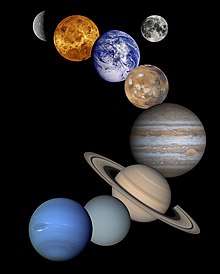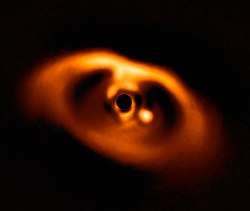List of planet types
The following is a list of planet types by their mass, orbit, physical and chemical composition, or by another classification.

From top to bottom: Mercury, Venus without its atmosphere, Earth and the Moon, Mars, Jupiter, Saturn, Uranus, and Neptune (not to scale)
The IAU defines that a planet in the Solar System must orbit around the Sun, has enough mass to assume hydrostatic equilibrium, and has "cleared its neighborhood". There is currently no accepted definition for exoplanets.
Under the IAU definition, true or "major planets" can be distinguished from other planetary-mass objects (PMOs), such as dwarf planets and sub-brown dwarfs. Nonetheless, certain planet types have been applied to other planetary-mass objects; the Pluto–Charon system has been referred to as "double dwarf planets", for instance.
By mass regime
| Planet type | Description |
|---|---|
| Giant planet | A massive planet. They are most commonly composed primarily of 'gas' (hydrogen and helium) or 'ices' (volatiles such as water, methane, and ammonia), but may also be composed primarily of rock. Regardless of their bulk compositions, giant planets normally have thick atmospheres of hydrogen and helium. |
| Mesoplanet | A planetary body with a size smaller than Mercury, but larger than Ceres. The term was coined by Isaac Asimov. Assuming "size" is defined by linear dimension (or by volume), mesoplanets should be approximately 1,000 to 5,000 km (620 to 3,110 mi) in diameter. |
| Mini-Neptune | Also known as a gas dwarf or transitional planet. A planet up to 10 Earth masses, but less massive than Uranus and Neptune. Mini-Neptunes have thick hydrogen–helium atmospheres, probably with deep layers of ice, rock or liquid oceans (made of water, ammonia, a mixture of both, or heavier volatiles). |
| Planemo | Also known as a planetary-mass object (PMO). An object which is hydrostatically round due to self-gravitation, but whose mass is insufficient to initiate fusion at its core to become a star. |
| Planetar | Either a brown dwarf—an object with a size larger than a planet but smaller than a star—that has formed by processes that typically yield planets—or a sub-brown dwarf, an object smaller than a brown dwarf that does not orbit a star. |
| Super-Earth | An extrasolar planet with a mass higher than Earth's, but substantially below the mass of the Solar System's smaller gas giants Uranus and Neptune, which are 13 and 17 Earth masses respectively. |
| Super-Jupiter | An astronomical object that's more massive than the planet Jupiter. |
| Sub-Earth | A classification of planets "substantially less massive" than Earth and Venus. |
By orbital regime
| Planet type | Description |
|---|---|
| Circumbinary planet | An exoplanet that orbits two stars. |
| Double planet | Also known as a binary planet. Two planetary-mass objects orbiting each other. |
| Eccentric Jupiter | A gas giant that orbits its star in an eccentric orbit. |
| Exoplanet | A planet that does not orbit the Sun, but a different star, a stellar remnant, or a brown dwarf. |
| Extragalactic planet | An exoplanet outside the Milky Way. |
| Goldilocks planet | A planet whose orbit that falls within the star's habitable zone. The name derives from the fairy tale "Goldilocks and the Three Bears", in which a little girl chooses from sets of three items, ignoring the ones that are too extreme (large or small, hot or cold, etc.), and settling on the one in the middle, which is "just right". |
| Hot Jupiter | A class of extrasolar planets whose characteristics are similar to Jupiter, but that have high surface temperatures because they orbit very close—between approximately 0.015 and 0.5 AU (2.2×106 and 74.8×106 km)—to their parent stars, whereas Jupiter orbits its parent star (the Sun) at 5.2 AU (780×106 km), causing low surface temperatures. |
| Hot Neptune | An extrasolar planet in an orbit close to its star (normally less than one astronomical unit away), with a mass similar to that of Uranus or Neptune. |
| Inferior planets | Planets whose orbits lie within the orbit of Earth.[nb 1] |
| Inner planet | A planet in the Solar System that have orbits smaller than the asteroid belt.[nb 2] |
| Outer planet | A planet in the Solar System beyond the asteroid belt, and hence refers to the gas giants. |
| Pulsar planet | A planet that orbits a pulsar or a rapidly rotating neutron star. |
| Rogue planet | Also known as an interstellar planet. A planetary-mass object that orbits the galaxy directly. |
| Superior planets | Planets whose orbits lie outside the orbit of Earth.[nb 1] |
| Trojan planet | A planet co-orbiting with another planet. The discovery of a pair of co-orbital exoplanets has been reported, but later retracted.[1] One possibility for the habitable zone is a trojan planet of a gas giant close to its star. |
By composition

Artist's impression of COROT-7b (in foreground), likely a lava exoplanet
| Planet type | Description |
|---|---|
| Chthonian planet | An extrasolar planet that orbits close to its parent star. Most Chthonian planets are expected to be gas giants that had their atmospheres stripped away, leaving their cores. |
| Carbon planet | A theoretical terrestrial planet that could form if protoplanetary discs are carbon-rich and oxygen-poor. |
| Coreless planet | A theoretical planet that has undergone planetary differentiation but has no metallic core. Not to be confused with the Hollow Earth concept. |
| Desert planet | A theoretical terrestrial planet with very little water. |
| Gas dwarf | A low-mass planet composed primarily of hydrogen and helium. |
| Gas giant | A massive planet composed primarily of hydrogen and helium. |
| Helium planet | A theoretical planet that may form via mass loss from a low-mass white dwarf. Helium planets are predicted to have roughly the same diameter as hydrogen–helium planets of the same mass. |
| Ice giant | A giant planet composed mainly of 'ices'—volatile substances heavier than hydrogen and helium, such as water, methane, and ammonia—as opposed to 'gas' (hydrogen and helium). |
| Ice planet | A theoretical planet with an icy surface and consists of a global cryosphere. |
| Iron planet | A theoretical planet that consists primarily of an iron-rich core with little or no mantle. |
| Lava planet | A theoretical terrestrial planet with a surface mostly or entirely covered by molten lava. |
| Ocean planet | A theoretical planet which has a substantial fraction of its mass made of water. |
| Protoplanet | A large planetary embryo that originates within protoplanetary discs and has undergone internal melting to produce differentiated interiors. Protoplanets are believed to form out of kilometer-sized planetesimals that attract each other gravitationally and collide. |
| Puffy planet | Also known as a hot Saturn. A gas giant with a large radius and very low density which is similar to or lower than Saturn's. |
| Silicate planet | A terrestrial planet that is composed primarily of silicate rocks. All four inner planets in our Solar System are silicon-based. |
| Terrestrial planet | Also known as a telluric planet or rocky planet. A planet that is composed primarily of carbonaceous or silicate rocks or metals. |
Other types
| Planet type | Description |
|---|---|
| Classical planets | The planets as known during classical antiquity: the Moon, the Sun, Mercury, Venus, Mars, Jupiter, and Saturn. |
| Earth analog | A planet with environmental conditions similar to those found on Earth. |
| Hypothetical planet | A planet or similar body whose existence is not proven, but is believed by some to exist. |
See also
Notes
- The four inner or terrestrial planets have dense, rocky compositions, few or no moons, and no ring systems. They are composed largely of refractory minerals, such as the silicates, which form their crusts and mantles, and metals, such as iron and nickel, which form their cores. Three of the four inner planets (Venus, Earth and Mars) have atmospheres substantial enough to generate weather; all have impact craters and tectonic surface features, such as rift valleys and volcanoes. The term inner planet should not be confused with inferior planet, which designates those planets that are closer to the Sun than Earth is (i.e. Mercury and Venus).
References
- "Two planets found sharing one orbit". New Scientist. 24 February 2011.
External links
- Periodic Table of Exoplanets at Planetary Habitability Laboratory, University of Puerto Rico at Arecibo
- A Thermal Planetary Habitability Classification for Exoplanets
- A Mass Classification for both Solar and Extrasolar Planets
- What Kinds of Planets Are Out There? at NASA
- Stern and Levison, "Regarding the criteria for planethood and proposed planetary classification schemes," Highlights of Astronomy 12 (2002)
- Lineweaver, C. H. and Robles, J. A. (2006). Towards a Classification System of Terrestrial Planets
- Out There: A Strange Zoo of Other Worlds
- SpaceEngine Planet Classifications
- A Planetary Classification Proposal
This article is issued from Wikipedia. The text is licensed under Creative Commons - Attribution - Sharealike. Additional terms may apply for the media files.
